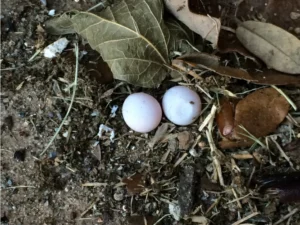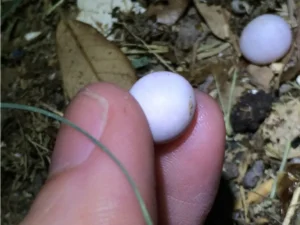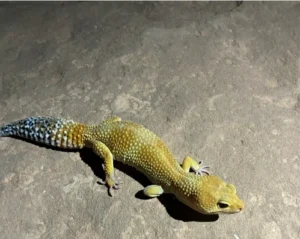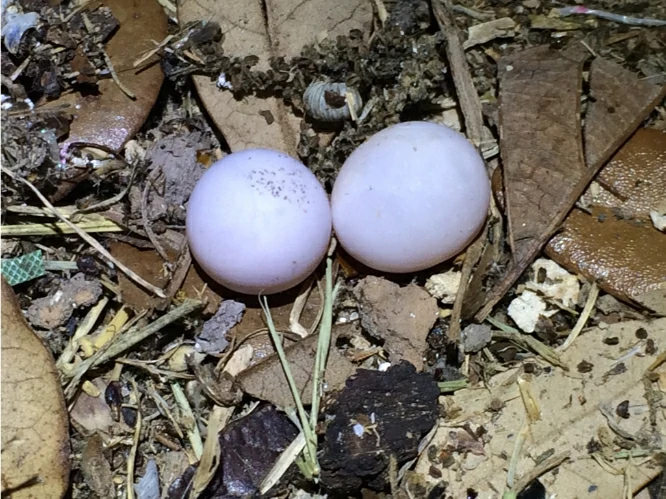You walk by your gecko’s tank one morning and spot two small white ovals tucked into a corner. You don’t remember pairing your gecko with a mate, so how did these eggs get here? Could a female gecko really lay eggs without a male?
Yes, female geckos can lay unfertilized eggs, even if no male is around. Just like chickens, they make eggs as part of their normal cycle. The eggs just won’t hatch because they’re not fertilized.
This surprises many new gecko owners, especially if their gecko lives alone. But it’s actually very common and completely normal.
How Female Geckos Make Eggs Without a Male
Inside every female gecko, there’s a pair of small organs called ovaries. These are like tiny factories that create eggs over time.
Hormones control the process, and it doesn’t matter if a male is present.

When the egg cells mature, they travel through the oviducts. Even without sperm, the shell hardens, and the egg is laid just like a normal one. It’s an unfertilized egg, but it looks almost the same as a fertilized one.
In other words, the body keeps doing its job whether or not reproduction actually happens.
Do All Female Geckos Lay Unfertilized Eggs?
Not all of them, but many do, especially mature females.
Leopard geckos, crested geckos, and house geckos are known to lay infertile eggs sometimes, even if they’ve never seen a male. Some females might lay once or twice a year, while others do it several times depending on temperature, diet, and hormones.
It’s kind of like how some birds lay eggs regularly as part of their cycle. It’s just biology at work.
How to Tell If the Eggs Are Fertilized or Not
At first, it’s almost impossible to tell. Both fertile and infertile eggs look white and oval. But there are a few small differences you can watch for over time:
- Fertile eggs stay firm, white, and may develop a pink or red “bullseye” when light passes through as the embryo starts growing.
- Infertile eggs often stay soft or collapse after a few days. They might turn yellowish or moldy if left in a humid spot.
If you’re curious, you can carefully “candle” the eggs by holding them up to a small light in a dark room. Fertile eggs will show faint veins inside, while unfertilized ones won’t.

Still, don’t stress. Infertile eggs are totally normal for unmated females.
What It Means When Your Gecko Lays Eggs Alone
Finding eggs in the tank when she’s been alone simply means her body is cycling normally. It’s not a sign that anything is wrong.
Laying eggs shows that your gecko is healthy enough to produce them. She’s getting enough food, warmth, and calcium to keep her system running.
But laying does use up energy and minerals, so it’s important to give her a little extra care afterward.
What To Do If Your Gecko Lays Unfertilized Eggs
If you find eggs, don’t panic.
Here’s what to do:
-
Leave her undisturbed at first. Egg-laying takes a lot out of her. Let her rest for a few hours.
-
Remove the eggs gently once she’s settled. You can discard them.
-
Check for more eggs. Many geckos lay in pairs, sometimes two, sometimes one.
-
Provide calcium and water. Offer a calcium-dusted meal and clean water to help her recover.
Think of it like your gecko running a marathon, she’ll need time and nutrients to get her strength back.
How Often Do Female Geckos Lay Unfertilized Eggs?
It depends on the species and the individual.
Leopard geckos can lay clutches (usually two eggs at a time) every few weeks during the breeding season, even without a male. Crested geckos may do the same every month or so.

Some females never lay unless they’ve mated. Others might lay one or two “practice” clutches early in adulthood and then stop for a long time.
It’s unpredictable, but not a problem unless she seems weak, dehydrated, or unable to pass the eggs.
Can a Gecko Get Egg-Bound Even With Unfertilized Eggs?
Yes, and this is important to watch.
“Egg-binding” means the gecko can’t release the eggs. It can happen whether they’re fertile or not. The eggs get stuck inside, which can be dangerous if not treated quickly.
You might notice your gecko acting restless, digging but not laying, or looking swollen in the belly. She might also stop eating or move slowly.
If you suspect this, don’t wait. A reptile vet can check with an X-ray and help her pass the eggs safely.
How to Help Prevent Egg-Binding and Stress
Even though laying unfertilized eggs is natural, it can still take a toll. You can make it easier for her by keeping her environment calm and nutrient-rich.
Here’s what helps most:
-
Provide a laying box: A small container with damp soil or moss gives her a place to dig and lay comfortably.
-
Maintain proper humidity: Dry air makes egg-laying harder.
-
Offer extra calcium: Use calcium powder with vitamin D3 to support shell formation and muscle strength.
-
Avoid frequent handling: Let her relax during egg-laying.
These small things make a huge difference in keeping her safe and stress-free.
What Happens to the Eggs After a While?
Unfertilized eggs won’t grow or hatch. Over a few days, they collapse or mold. If left in a warm, humid tank, they might even smell.

That’s why it’s best to remove them soon after you find them. Some keepers bury them in the garden, while others just throw them away. Either way is fine, they’re not living embryos.
It might feel strange at first, but remember, these eggs were never going to develop.
Why Unfertilized Eggs Are Nothing to Worry About
Many new owners think unfertilized eggs mean something went wrong. But it’s just part of your gecko’s natural rhythm.
Just like humans have hormonal cycles, female geckos have their own. When hormones rise, eggs form. If no mating happens, they’re laid anyway. The process repeats.
It’s the body’s way of keeping reproductive systems healthy and ready, just in case.
What to Expect From Your Gecko After Laying
After laying, your gecko might look slimmer or less active for a few days. She may eat less or spend more time resting in her hide.
That’s normal, egg production uses a lot of energy.
Make sure she has easy access to water and food, and offer extra calcium. Once she recovers, she’ll go back to her usual curious self.
Some females go through this every few months; others once a year or less. It’s different for each one, just like people’s cycles.
Should You Ever Try to Incubate the Eggs?
If you’re sure your gecko hasn’t mated, there’s no point. The eggs won’t hatch. You can experiment if you want to observe (some people put them in a small container with moist vermiculite) but they’ll usually mold or collapse in a week or two.
If you’re not completely sure whether they’re fertile, it doesn’t hurt to keep them safe for a week before deciding. Handle them gently and never flip them upside down.
How You Can Support a Laying Female
Here’s a quick list of small but helpful ways to support your gecko during egg-laying:
-
Keep temperatures steady between 80–90°F (27–32°C).
-
Offer a calcium dish she can lick from when needed.
-
Mist her tank lightly to keep humidity comfortable.
-
Give her privacy, stress can make laying harder.
-
Monitor her weight before and after laying.
Doing this helps prevent health issues and keeps her strong for the next cycle.
Conclusion
So, do geckos lay unfertilized eggs?
Yes, and quite often. It’s their body’s natural way of cycling through reproduction, whether or not a male is present.
Unfertilized eggs look real but won’t hatch. They’re harmless, though they can tire your gecko out for a few days. With a bit of calcium, rest, and humidity, she’ll bounce right back.
In short, if you wake up to a few mysterious eggs in the tank, don’t panic. Your gecko’s just following her natural rhythm, doing exactly what her body was designed to do.
Hi, my name is Ezra Mushala, i have been interested animals all my life. I am the main author and editor here at snakeinformer.com.

